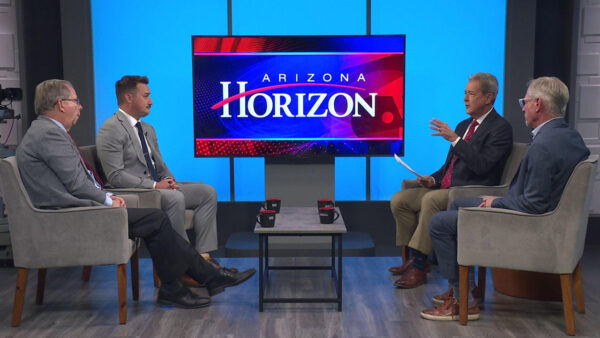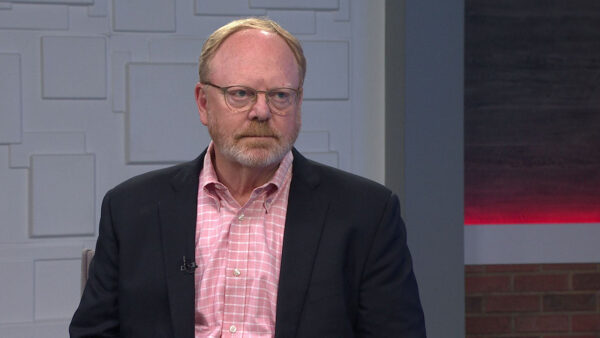Local artist Laura Spalding Best will have her paintings on display at the Burton Barr Library in Phoenix through August 8. Her paintings explore the urban landscape. Best will talk about her work and the display.
Ted Simons: Tonight's "Arizona Artbeat" looks at the work of urban landscape artist Laura Spalding Best, who paints street scenes in ways to emphasize unappreciated flaws in our everyday views. We should note her paintings are on display at the Burton Barr Library through August 8th. Urban landscape, why?
Laura Spalding Best: I started painting the urban landscape of Phoenix almost years ago. Because I realized some of the landscapes I had been painting were from further away and kind of idealized and not representing what you saw every day.
Ted Simons: Define an urban landscape.
Laura Spalding Best: Part of our everyday views. So it's anything from buildings and downtown Phoenix, to the signs on the freeways and telephone poles and utility poles.
Ted Simons: Can you compare to traditional landscapes? If compositionally you can.
Laura Spalding Best: Well, yeah, one of the biggest things we share in composition, especially with traditional western landscapes, is the big sky and the horizon of the west. That's still something I try to capture about the desert environment. But I leave everything in that surrounds us.
Ted Simons: The title of your show is called Interconnections.
Laura Spalding Best: Uh-huh.
Ted Simons: Why that title?
Laura Spalding Best: It's the physical linking of two different networks in the telecommunications system or the electrical grid, and that's where that came from. And of course it kind of mirrors some of the things I try to explore in my work, which is our connection to each other as a community through our visual experience every day, and literally through the connections of telephone lines and utility poles, how we're all actually connected.
Ted Simons: With that said, let's take a look at some of your artwork here. When you see a telephone pole, some of these things, these power poles here, do you see them and go, that would be a nice pinwheel? How does the creative process work?
Laura Spalding Best: For that, that was a long time coming from starting, which is sort of simple urban landscapes that were a reflection of what I was seeing. They have brought it to a point where it's a little bit more conceptual. These radial compositions, I'm showing the telephone poles on one street the way you would never see them together. One is all the utility poles of Farmer Avenue. There's of them and they are all very different in a unique -- in their own way.
Ted Simons: But again, do you think this through at first or somewhere in your mind you're saying, I'm seeing something in a circle there. You think it through first?
Laura Spalding Best: It comes from a tradition of pattern and art and mandalas and things like that.
Ted Simons: Exactly. And when you're done and step back, does it ever surprise you?
Laura Spalding Best: Oh, yeah, all the time. That's a really rewarding part of being up close painting something, taking a few steps back.
Ted Simons: You've mentioned Farmer Avenue in Tempe.
Laura Spalding Best: Uh-huh.
Ted Simons: You drive around and you see a power pole with lines coming here and there, most of us would say, that transformer looks terrible. Do you say --
Laura Spalding Best: Yes, I do. I'm inspired every day by things that are part of my morning commute and that I see driving from my neighborhood.
Ted Simons: We see these things and we don't concentrate on these things. When you concentrate on something like this, this is an everyday view we're looking at. When you concentrate, what are you looking for? Is there something that's not being seen that should be seen?
Laura Spalding Best: Yeah, I think there are all these hidden dynamic views in our landscape. Once you start to look for them you see them more and more.
Ted Simons: What got you started in art?
Laura Spalding Best: I've been an artist since I was really young, but I pursued my BFA in painting at ASU and graduated in .
Ted Simons: These are paintings, aren't they?
Laura Spalding Best: They are all oil paintings. I work on -- I paint on metal.
Ted Simons: Why those particular materials?
Laura Spalding Best: I just love painting on metal. I started out by painting on some metal found objects. And the metal is such a natural surface for oil, especially on aluminum, it's very archival. The way the paint applies to that surface is wonderful. I've used the metal surface as part of background to represent the sky and left that exposed rather than always painted over.
Ted Simons: Interesting. Again, when did you decide -- was there a point where you said -- I'm assuming you painted flowers or something.
Laura Spalding Best: I painted people, sure.
Ted Simons: When did people become landscape art? Was there an aha moment?
Laura Spalding Best: Yeah, I went on a trip where I did a lot of more traditional landscape painting because I was out further in nature. And when I came back I really wanted to keep doing that and describe space and place. So that's where all this came from.
Ted Simons: Will you go back to doing landscape nature?
Laura Spalding Best: I'll go to what's around me, but I might always jump back to people.
Ted Simons: And you're Phoenix-based, correct?
Laura Spalding Best: Yes.
Ted Simons: Why do you stay in Phoenix?
Laura Spalding Best: I came out here for school and just loved it. I've never felt the need to leave. I've lived here for 14 years.
Ted Simons: Interesting. Talk about the local arts community,ist the supportive or best that they are out there on their own?
Laura Spalding Best: It can feel like artists are out there on their own. I was part of an arts collective for three years and I work at the Scottsdale Museum of Contemporary Art, so I really get to see a lot of effort into the arts in the community.
Ted Simons: In 14 years have you ever seen that change?
Laura Spalding Best: Yeah, I've seen us get closer to a more active and dynamic art scene over that time, from fledgling first Fridays into the early 2000s to how it is now.
Ted Simons: And art tours.
Laura Spalding Best: Yeah.
Ted Simons: Optimistic about art and the future of artists in the Valley?
Laura Spalding Best: Yeah, in my personal experience it's only got better.
Ted Simons: What's next for you?
Laura Spalding Best: More exhibitions and more painting.
Ted Simons: I guess we can't run out of urban landscape, can we?
Laura Spalding Best: We'll see where it goes.
Ted Simons: Congratulations on your work and now sharing it here.
Laura Spalding Best: Thank you so much.
Laura Spalding Best:Arizona Artist;























